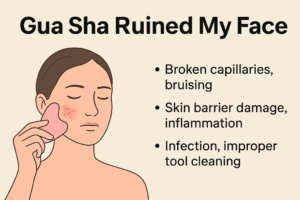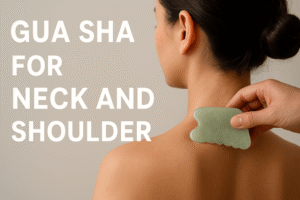
In today’s fast-paced and demanding world, stress has become an inevitable part of our lives. It affects our physical and emotional well-being, often leading to fatigue, anxiety, and a sense of being overwhelmed. While there are various approaches to managing stress, one ancient healing technique that has gained popularity in recent years is Gua Sha. With its roots in Traditional Chinese Medicine, Gua Sha offers a holistic approach to stress reduction, promoting relaxation and emotional well-being. Let’s explore how Gua Sha can be a valuable tool in managing stress.
Understanding Stress and Its Impact
Before delving into Gua Sha, it’s important to understand stress and its impact on our bodies and minds. Stress is the body’s response to external pressures, whether they are physical, emotional, or psychological. While stress can be helpful in certain situations, chronic stress takes a toll on our overall well-being. It affects our nervous system, leading to imbalances and a heightened stress response.
Prolonged stress can manifest in various ways, including muscle tension, headaches, digestive issues, sleep disturbances, and mood swings. It’s crucial to address stress and find effective coping mechanisms to maintain a healthy and balanced lifestyle.
Gua Sha: An Ancient Healing Practice
Gua Sha, which translates to “scraping sand,” is an ancient healing technique that originated in East Asia thousands of years ago. It involves gently scraping the skin’s surface using a smooth-edged tool, typically made of jade, horn, or other materials. The purpose of Gua Sha is to stimulate blood flow, remove stagnant energy, and promote healing and well-being.
Gua Sha has been an integral part of Traditional Chinese Medicine for centuries. It is believed that by applying pressure and scraping the skin, Gua Sha helps release tension, improve circulation, and restore balance within the body.
How Gua Sha Reduces Stress

One of the key ways Gua Sha helps reduce stress is by activating the body’s parasympathetic nervous system, which is responsible for the “rest and digest” response. When we are stressed, our sympathetic nervous system, responsible for the “fight or flight” response, dominates. Gua Sha helps shift the body into a state of relaxation by calming the nervous system and promoting a sense of tranquility.
Another mechanism through which Gua Sha reduces stress is by improving blood circulation. The scraping motion stimulates the flow of blood and lymphatic fluid, aiding in the removal of toxins and promoting overall well-being. The increased circulation also facilitates the delivery of oxygen and nutrients to the cells, supporting their optimal function.
Additionally, Gua Sha helps release muscle tension and tightness, which are common physical manifestations of stress. By gently scraping the skin, Gua Sha encourages the muscles to relax, alleviating pain and discomfort.
Techniques and Tools for Gua Sha
Gua Sha can be performed using various techniques and tools, each offering its unique benefits. The most common tools used for Gua Sha are smooth-edged stones made of jade, rose quartz, or buffalo horn. These tools are carefully applied to the skin in specific strokes and patterns, depending on the area of the body being treated.
To perform Gua Sha, start by applying a lubricant such as oil or lotion to the skin. This helps the tool glide smoothly without causing friction or discomfort. Hold the tool at a 15 to 45-degree angle and apply gentle pressure while scraping the skin in long, sweeping strokes. The pressure should be firm enough to engage the tissues but gentle enough to avoid causing pain.
It’s essential to remember that Gua Sha should never cause pain or bruising. If you experience any discomfort, it’s advisable to adjust the pressure or seek guidance from a trained practitioner.
When performing Gua Sha, it’s important to follow the natural flow of the body’s meridians or energy pathways. These meridians are believed to connect various organs and systems, and by working along these pathways, Gua Sha helps restore balance and harmony.
While Gua Sha can be performed by oneself at home, it is recommended to learn from a qualified practitioner initially to ensure proper technique and safety. They can provide guidance on specific areas of focus, intensity of pressure, and duration of the practice.
Benefits of Gua Sha for Relaxation and Emotional Well-being

Gua Sha offers a multitude of benefits for relaxation and emotional well-being. Here are some ways in which Gua Sha can positively impact your stress levels:
1. Relaxation and Tension Release:
Gua Sha helps release muscle tension and tightness, allowing the body to relax. As the tool glides across the skin, it promotes a sense of soothing relief, melting away stress-induced knots and discomfort.
2. Improved Sleep Quality:
By promoting relaxation and reducing physical tension, Gua Sha can contribute to better sleep quality. When the body is more relaxed, it is easier to fall asleep and experience restful sleep, aiding in overall rejuvenation and stress reduction.
3. Emotional Balance:
Gua Sha not only addresses physical tension but also supports emotional balance. The gentle scraping motion and the overall relaxation it induces can help calm the mind, ease anxiety, and promote a sense of emotional well-being.
4. Enhanced Mind-Body Connection:
Engaging in regular Gua Sha sessions encourages mindfulness and fosters a deeper connection between the mind and body. It allows you to be more present in the moment, promoting self-care and self-awareness.
5. Self-Care Ritual:
Incorporating Gua Sha into your self-care routine provides an opportunity for self-nurturing and self-love. Taking the time to perform Gua Sha allows you to prioritize your well-being, creating a sense of inner peace and rejuvenation.
Incorporating Gua Sha into Your Self-Care Routine
Integrating Gua Sha into your self-care routine is a wonderful way to manage stress and promote relaxation. Here are some practical tips to help you incorporate Gua Sha into your daily life:
1. Choose the Right Time and Place:
Find a quiet and peaceful space where you can perform Gua Sha without interruptions. Create a calming atmosphere by lighting candles, playing soothing music, or diffusing essential oils.
2. Prepare Your Skin:
Cleanse your face or the area of the body you wish to treat before starting the Gua Sha practice. Apply a few drops of facial oil or body lotion to ensure smooth gliding of the tool.
3. Follow a Consistent Routine:
Consistency is key when it comes to Gua Sha. Aim for regular practice, whether it’s daily, a few times a week, or as needed. Set aside dedicated time for your Gua Sha practice and make it a priority in your schedule.
4. Focus on Areas of Tension:
Identify areas of your body where you hold tension, such as the neck, shoulders, or jaw. Spend extra time gently working on these areas, using slow and deliberate strokes to release the tension.
5. Listen to Your Body:
Pay attention to how your body responds during and after Gua Sha sessions. Listen to any signals of discomfort or sensitivity and adjust the pressure or technique accordingly. Everyone’s experience with Gua Sha may vary, so trust your intuition and adapt to what feels right for you.
6. Combine Gua Sha with Other Relaxation Techniques:
Enhance the benefits of Gua Sha by combining it with other relaxation techniques. Practice deep breathing exercises, meditation, or gentle stretches before or after your Gua Sha session to amplify the overall relaxation and stress-reducing effects.
7. Seek Professional Guidance:
If you’re new to Gua Sha or have specific concerns, it can be beneficial to seek guidance from a trained Gua Sha practitioner or a healthcare professional. They can provide personalized recommendations and ensure you’re using proper techniques for your individual needs.
Precautions and Considerations
While Gua Sha is generally safe and well-tolerated, it’s important to keep a few precautions in mind:
- Avoid Broken or Inflamed Skin: Do not perform Gua Sha on areas with open wounds, broken skin, rashes, or sunburns. Gua Sha should only be applied to intact and healthy skin.
- Moderate Pressure: Apply moderate pressure during Gua Sha to avoid bruising or discomfort. The goal is to engage the tissues gently without causing pain.
- Consult a Healthcare Professional: If you have any underlying medical conditions, are pregnant, or have concerns about incorporating Gua Sha into your routine, consult with a healthcare professional before proceeding.
- Hygiene and Cleanliness: Ensure that your Gua Sha tool is clean and sanitized before each use to maintain good hygiene and prevent infections.
By adhering to these precautions and considering your individual circumstances, you can enjoy the benefits of Gua Sha safely and effectively.
Conclusion
Gua Sha offers a valuable approach to managing stress, promoting relaxation, and supporting emotional well-being. With its ancient roots in Traditional Chinese Medicine, this gentle scraping technique has the power to release tension, improve circulation, and restore balance within the body.
Incorporating Gua Sha into your self-care routine can be a transformative practice. By dedicating time to care for your body and mind, you nurture a sense of calm, reduce stress levels, and enhance your overall well-being.
So, why not embrace the power of Gua Sha as a holistic approach to stress reduction? Take the time to explore this ancient healing technique, and allow yourself the opportunity to experience deep relaxation and emotional harmony.
Remember, self-care is not selfish—it is an essential aspect of maintaining a healthy and balanced life. Prioritize your well-being and make Gua Sha a part of your journey towards a more relaxed and emotionally fulfilled existence.






